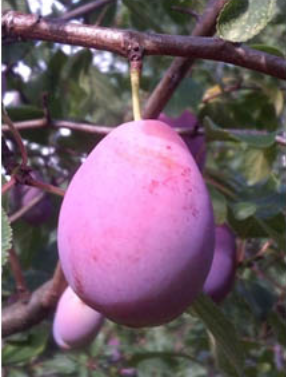Crop: Prunus domestica L. (Plum)
Plants of ‘Mascina di Montepulciano’ (P. domestica L. subsp. insititia) are characterised by weak vigour and a compact tree habit. Fruits are typically purple and characterised by a yellow pulp; at maturity seeds are well attached to the pulp. The fruit shape is oblong. Fruits of ‘Mascina di Montepulciano’ are very appreciated for their high content in sugars (sweet) but at the same time also by high content of compounds that provide a strong sour taste. Plants appear to be extremely resilient and within the cultivation area are traditionally used to produce ‘wild’ rootstocks for other P. domestica varieties. The harvest is carried out between the end of July and mid-August. Some farmers use mechanical harvester (shakers) while others directly collect fruits from the ground. Collecting fruits directly from the ground (occurrence of fruit over-ripening) allows farmer to produce plum jams without using additional sugars; this way some farmers also kept traditional processing of ‘Mascina di Montepulciano’.
Cultivation System: Low input conditions.
Geographical Information
Country: Italy
‘Mascina di Montepulciano’ was cultivated within the Chiana valley (central Italy), especially under the municipalities of Montepulciano, Chiusi and Chianciano Terme (Province of Siena, Italy). However, various individuals were also found. Currently its cultivation is mainly carried out under the municipality of Montepulciano.
Farmer(s) description:
Generally, few plants are conserved on-farm. Typically, plants are conserved within different farms and small private orchards only for family consumption. Within the traditional cultivation area two farmers planted circa 2 ha each using ‘Mascina di Montepulciano’. The first orchard was planted circa 35 years ago while the second one in recent years, testifying the interest and the market potential on this landrace has been growing until now.
Propagation system: Clonal
Multiplication procedures and consequences on landrace diversity:The traditional multiplication procedure of ‘Mascina di Montepulciano’ relies on the use of root sprouts (adventitious sprouts) that are separated from the mother plant by cutting a portion of root (sucker division). The root sprouts are then used as vegetative propagation material.
Such clonal multiplication procedure allows to produce plant equal to the mother plant.
Management plan existence:The landrace management relies completely on farming activities in the area. Currently, no technical or scientific support is given.
Added Values
In recent years the market of ‘Mascina di Montepulciano’ grown quickly both locally and nationally. The fresh fruits are characterised by a very short shelf-life that does not allow their distribution and commercialisation. Thus, fruit of this landrace are mainly processed to produce jams.
Others (e.g. commercial/geographical brands or special traits):‘Mascina di Montepulciano’ has been recognized as ‘Prodotto Agroalimentare Tipico’ (PAT, litteraly Typical Food Product) by the Italian Ministry of Agriculture and Forestry through the technical support of Regione Toscana. The PAT recognition is based on evidences that demonstrate the use of a landrace (or a processed foodstuff) in a certain area for at least 25 years.
Currently the Department of Agricultural Food and Environmental Science of the University of Perugia is carrying out phenotypic and genetic characterisation of the landrace in order to promote its registration to the regional register of landraces and to promote other activities (i.e. valorisation, conservation).
Provisions set by the Italian Ministry of Agriculture and Forestry, ‘Regione Toscana’ and local associations, the high quality of the product, the increased perception of the landrace value and a renewed interest in agriculture give hope of on-farm conservation in the next future.
Information on the diversity within the landrace would allow to establish proper actions optimize on farm conservation strategies.
Uncertain. To have access to the resource please contact:
Regione Toscana http://germoplasma.regione.toscana.it/
Case study prepared by Dipartimento di Scienze Agrarie, Alimentari e Ambientali (DSA3), Università degli Studi di Perugia (UNIPG), Italy.
Most of updates have been communicated by Niccolò Terzaroli (Università degli Studi di Perugia).
ND.
